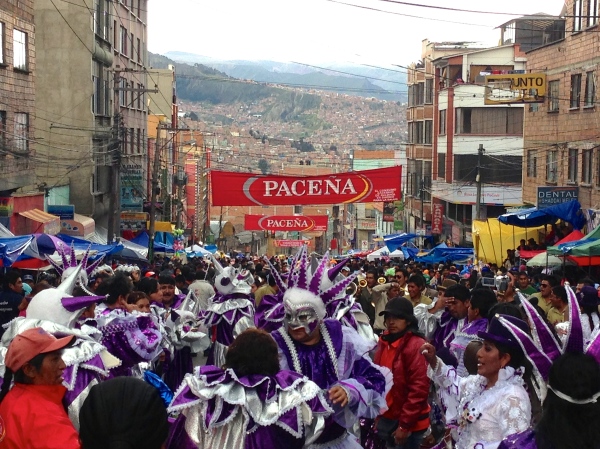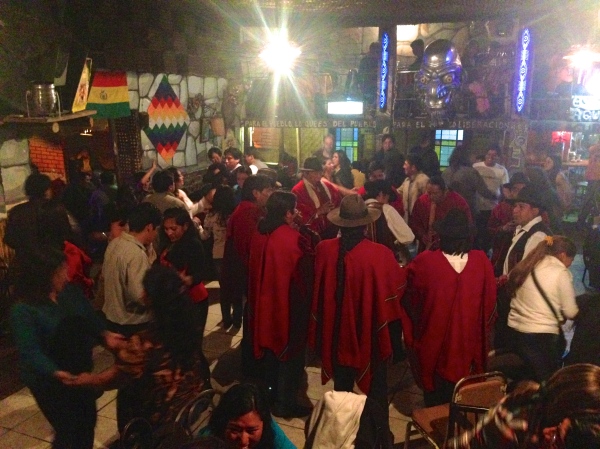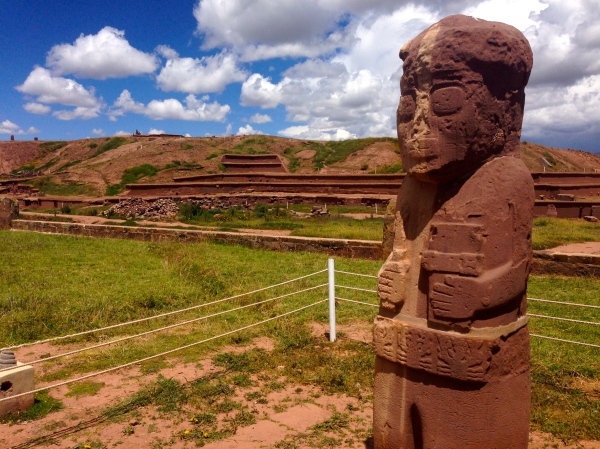After our exhilarating time in Copacabana and on Isla del Sol, which included reuniting with Christian, our German friend from Cusco, we purchased a bus ticket to La Paz for 15 Bolivianos ($2.17). We wound our way around Lake Titicaca until we came to an abrupt halt and were told to exit the bus, purchase tickets for a ferry, and meet the bus on the other side. Some of our fellow travelers were more prepared than we were for the required travel change and hopped aboard our small boat armed with chocolate crackers and six packs of beer. We admired the industry of this small town while crossing the lake, and once on land, admired the pageantry of the town’s carnival parade and celebration in the small square.
Back on the bus, we soon found ourselves descending, and suddenly La Paz appeared. La Paz rests in a valley surrounded by stalactite looking mountains, and snow capped mountains in the distance. Our first night in La Paz was incredible; our host took us to a peña, which is a local club that specializes in folk dancing. We found a table directly overlooking the dance floor and ordered a few large beers to share. Gradually, the locals began to take interest in the three gringos enjoying themselves in their club, and began to challenge / invite us to participate. A local woman offered us coca leaves and we poured her a little beer in return. She eventually invited us to join her table, at which point her boyfriend took control of hosting responsibilities, pouring glass after glass of a Bolivian version of pisco mixed with orange juice for our group. We soon found ourselves smiling ear to ear, dripping in sweat, and surrounded on the dance floor with locals teaching us the variety of dances that corresponded with the type of music the DJ played.
Aside from our initial peña indulgence, we didn’t go to any other bars, or attempt to enjoy any more nightlife. Instead, we spent our time touring the city’s markets and sampling all of the alluring soups, meals and snacks, before cooking dinner and conversing with our host. One afternoon, our host took us to La Paz Alto (the part of La Paz that has expanded out of the valley) to participate in Carnival celebrations. We were a bit hesitant after our attack-the-gringos experience in Peru, but the energy was completely different in Bolivia. Although we did get sprayed with foam a time or two, the people were far more welcoming, and many of the dancers (who we later found out danced or played their instruments for hours from La Paz up the side of the valley to La Paz Alto) took pictures with us in their beautifully decorated traditional garb.
The lowlight of our time in La Paz was marked by our visit to Tiwanaku and Puma Punku. We took a minivan from our host’s neighbourhood through the entire city to El Cementario, where we transferred to another minivan that offered to take us directly to the ruins. The first strike against this experience was the fact that we were forced to pay the same amount to go an hour and a half as we did to get from Copacabana to La Paz (3.5 hours). The second, and most egregious violation, was the fact that they charged foreigners 80 Bolivianos compared to the 10 Bolivianos locals were charged.
Don’t mistake us, we completely support any tactics that encourage Bolivians to visit more archeological sites and museums that pertain to their history, however, not offering student discounts while charging tourists eight times what locals pay is probably not the surest road to sustainable tourism. Strike three came in the form of the ruins themselves. Simply consulting Wikipedia will inform you that Tikwanaku is one of the most important civilizations prior to the Inca Empire, flourishing as the ritual and administrative capital of a major state power from 300 to 1000 AD. Its location between the lake and dry highlands provided key resources of fish, wild birds, plants, herding ground for llamas, while also serving as a moral and cosmological center to which many people made pilgrimages.
Nevertheless, the placards simply stated the obvious: “The walls are east / west oriented and the sculptures face the center.” Seriously? Impressive. We would have appreciated a bit more information concerning the motivation for creating these structures and how they were used. Perhaps a fraction of information discussing the culture of the people who built and inhabited these alters. We even went so far as to follow a tour around to eavesdrop in hopes of gaining some insight into the people who lived at the time of these ruins’ prominence. Unfortunately, there wasn’t much more offered then the information posted on signs.





